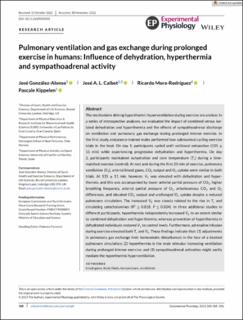| dc.contributor.author | González-Alonso, José | |
| dc.contributor.author | Mora-Rodríguez, Ricardo | |
| dc.contributor.author | Calbet, José Antonio Lopez | |
| dc.contributor.author | Kippelen, Pascale | |
| dc.date.accessioned | 2023-10-17T07:18:13Z | |
| dc.date.available | 2023-10-17T07:18:13Z | |
| dc.date.created | 2023-03-10T12:37:04Z | |
| dc.date.issued | 2023 | |
| dc.identifier.citation | Experimental Physiology. 2023, 108(2), Side 188-206. | en_US |
| dc.identifier.issn | 0958-0670 | |
| dc.identifier.uri | https://hdl.handle.net/11250/3096846 | |
| dc.description | This is an open access article under the terms of the Creative Commons Attribution License, which permits use, distribution and reproduction in any medium, provided the original work is properly cited. | en_US |
| dc.description.abstract | The mechanisms driving hyperthermic hyperventilation during exercise are unclear. In a series of retrospective analyses, we evaluated the impact of combined versus isolated dehydration and hyperthermia and the effects of sympathoadrenal discharge on ventilation and pulmonary gas exchange during prolonged intense exercise. In the first study, endurance-trained males performed two submaximal cycling exercise trials in the heat. On day 1, participants cycled until volitional exhaustion (135 ± 11 min) while experiencing progressive dehydration and hyperthermia. On day 2, participants maintained euhydration and core temperature (Tc) during a time-matched exercise (control). At rest and during the first 20 min of exercise, pulmonary ventilation (VE), arterial blood gases, CO2 output and O2 uptake were similar in both trials. At 135 ± 11 min, however, VE was elevated with dehydration and hyperthermia, and this was accompanied by lower arterial partial pressure of CO2, higher breathing frequency, arterial partial pressure of O2, arteriovenous CO2 and O2 differences, and elevated CO2 output and unchanged O2 uptake despite a reduced pulmonary circulation. The increased VE was closely related to the rise in Tc and circulating catecholamines (R2 ≥ 0.818, P ≤ 0.034). In three additional studies in different participants, hyperthermia independently increased VE to an extent similar to combined dehydration and hyperthermia, whereas prevention of hyperthermia in dehydrated individuals restored VE to control levels. Furthermore, adrenaline infusion during exercise elevated both Tc and VE. These findings indicate that: (1) adjustments in pulmonary gas exchange limit homeostatic disturbances in the face of a blunted pulmonary circulation; (2) hyperthermia is the main stimulus increasing ventilation during prolonged intense exercise; and (3) sympathoadrenal activation might partly mediate the hyperthermic hyperventilation. | en_US |
| dc.language.iso | eng | en_US |
| dc.subject | blood gases | en_US |
| dc.subject | body fluids | en_US |
| dc.subject | temperature | en_US |
| dc.subject | ventilation | en_US |
| dc.title | Pulmonary ventilation and gas exchange during prolonged exercise in humans: Influence of dehydration, hyperthermia and sympathoadrenal activity | en_US |
| dc.type | Peer reviewed | en_US |
| dc.type | Journal article | en_US |
| dc.description.version | publishedVersion | en_US |
| dc.rights.holder | © 2023 The Authors | en_US |
| dc.source.pagenumber | 188-206 | en_US |
| dc.source.volume | 108 | en_US |
| dc.source.journal | Experimental Physiology | en_US |
| dc.source.issue | 2 | en_US |
| dc.identifier.doi | 10.1113/EP090909 | |
| dc.identifier.cristin | 2133016 | |
| dc.description.localcode | Institutt for fysisk prestasjonsevne / Department of Physical Performance | en_US |
| cristin.ispublished | true | |
| cristin.fulltext | original | |
| cristin.qualitycode | 1 | |

